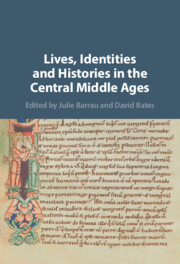Book contents
- Lives, Identities and Histories in the Central Middle Ages
- Lives, Identities and Histories in the Central Middle Ages
- Copyright page
- Contents
- Figures
- Contributors
- Abbreviations
- Introduction
- Part I Entwined Lives and Multiple Identities
- 1 Mother and Motherhood in the Vita et Passio Willelmi Norwicensis
- 2 Prayer for the Dead:
- 3 Authority over Men and the Allocation of Riches:
- 4 Flemish Settlement and Maritime Traffic in the South-West Peninsula of Britain, c. 1050–1250
- 5 Cistercians and the Laity in Twelfth- and Thirteenth-Century Upper Normandy
- 6 Memory and Trauma:
- 7 New Charters of the Empress Matilda, with Particular Reference to Her Reception at Gloucester in 1139
- 8 Female Identity before 1250:
- Part II Historians, Lawyers and Exegetes: Writing Lives and Identities
- Index
8 - Female Identity before 1250:
The Preudefemme
from Part I - Entwined Lives and Multiple Identities
Published online by Cambridge University Press: 24 September 2021
- Lives, Identities and Histories in the Central Middle Ages
- Lives, Identities and Histories in the Central Middle Ages
- Copyright page
- Contents
- Figures
- Contributors
- Abbreviations
- Introduction
- Part I Entwined Lives and Multiple Identities
- 1 Mother and Motherhood in the Vita et Passio Willelmi Norwicensis
- 2 Prayer for the Dead:
- 3 Authority over Men and the Allocation of Riches:
- 4 Flemish Settlement and Maritime Traffic in the South-West Peninsula of Britain, c. 1050–1250
- 5 Cistercians and the Laity in Twelfth- and Thirteenth-Century Upper Normandy
- 6 Memory and Trauma:
- 7 New Charters of the Empress Matilda, with Particular Reference to Her Reception at Gloucester in 1139
- 8 Female Identity before 1250:
- Part II Historians, Lawyers and Exegetes: Writing Lives and Identities
- Index
Summary
There is an extensive vernacular conduct literature of the twelfth and thirteenth century that has barely been used by social historians.This is all the more surprising as it has a considerable amount to say on central social issues, not least gender. This chapter analyses what several conduct tracts have to say about just one such aspect, femininity, beginning with the earliest conduct tract of all, addressed to women by the aristocratic Occitan author Garin lo Brun in the first half of the twelfth century. We find that Garin and other authors, notably the prolific thirteenth-century social commentator Robert de Blois, described and defined an idealised superior woman: the preudefemm or biderbe wip who summed up in herself the contemporary gender expectations of the female of the twelfth and thirteenth centuries. Importantly, it is an ideal of femininity generated within lay society and not out of the Latin literature of the schools previously used for the purpose by scholars, tainted with clerical misogyny as it is. The result goes a long way to explain the potential and limits of the female agency recent gender scholarship has suggested was to be found in medieval society.
Keywords
- Type
- Chapter
- Information
- Lives, Identities and Histories in the Central Middle Ages , pp. 142 - 158Publisher: Cambridge University PressPrint publication year: 2021

